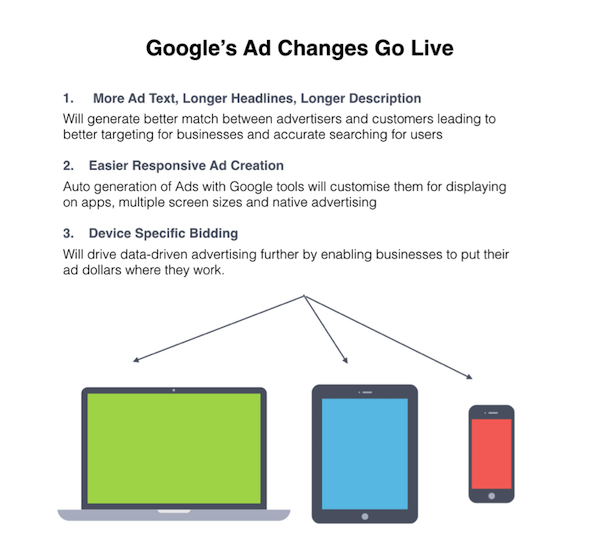Google’s Longer Ad Text is Now Live. Better Lead Quality for Businesses
Effective advertising with relevant search results for user, better leads for business.
Google Ads will now have 2 headlines, each with 30 characters, and a long description of 80 characters. That is 50% more ad text to display information about the product or service. The reason for this change is that Google’s research showed the longer ad headlines helped people identify the information they needed better and they could then click on links most relevant to them.
This is a win-win for both – advertisers and customers. While customers find what they are looking for more easily, advertisers get more relevant leads with a greater potential to improve their conversion rates. That means fewer dollars lost to clicks that won’t convert. For the user, who is Google’s primary customer, search results are more accurate. It also delivers a better user experience with uniform display across all devices, desktop, tablet and mobile, benefiting both the user and the advertiser.
While all new ads would have to be in the new longer text format, older ads with the shorter text will run until October 26, 2016, to give businesses time to make the transition.
Google had announced it would be making this change at the Google Mobile Summit in May. It is a part of Google’s move to the Mobile First platform.
Given that there is some time to make the changes, Google has suggested guidelines:
- Use A/B testing to test a few different versions of the longer text ads for each ad group. This will give data on wording that works the best.
- Retain the tried and tested elements from the old ads, maybe price and important keywords
- Work on the headline – it is now the key factor of great click-through rates and conversions.
Google’s Adwords creating tools as well as other software have already made changes to support the longer text format.
These changes will involve a fair bit of work for campaigns currently running ads based on several ad groups. Expect to put in a few hours of work for each ad – copywriting, testing and tweaking the ads. It’s well worth the effort, because if you get the new copy right, the ads will be better targeted and should result in higher conversions and a better cost per conversion rate.

Creating responsive ads will be easier
In a related development, Google is making life a whole lot easier for advertisers and small businesses. In making an ad, an advertiser has to submit a 25 character and 90-character headline, a 90-character description and image and a URL. Google’s responsive ad tool will then design and render ads that fit perfectly across the Google Display Network (GDN) and also across two million apps. This is a big move for advertisers as it will unlock native advertising, which is often more effective as it matches the look and feel of the content the user is viewing.
Spend your advertising dollars where they work
The beauty of digital advertising is that real time data tells you what’s working and what’s not. And that enables advertisers to move their allocation across a range of advertising options. Now you can tweak your spending across devices as well.
Businesses, based on the product or service they sell, will have a different traffic rates coming from desktop, tablet and mobile. Or they may have different kinds of content being accessed based on the device the traffic is coming in from.
To allow advertisers to fine tune their spending to device specific traffic, click-through rates and conversion, Google has introduced device specific bidding on AdWords. A good digital marketer should be able to use device-specific bidding to improve the conversion funnel. Finding the right formula may need a bit of experimenting, but the move greatly improves the potential for businesses to maximise gains from their ad dollars.
You can find out more here:
https://adwords.googleblog.com/2016/07/three-ad-innovations-for-mobile-first-world.html
